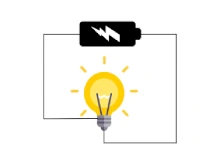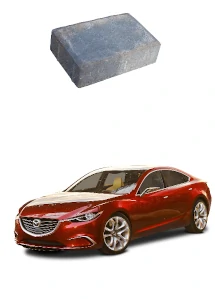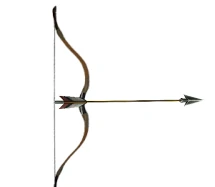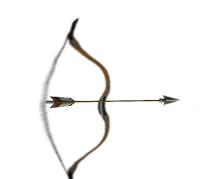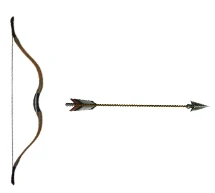Work, Power & Energy
In this article, we will be learning about different types of energy. We will mainly focus on Kinetic and Potential energy in this article.
We will also be learning about work done. We will go through the different scenarios of work done and learn about situations in which there is no work done.
What is Energy?
Energy is the capacity to do work. The SI unit of energy is Joule (J).
Energy is a scalar quantity. It has only magnitude and no direction.
Forms of Energy
Some of the different forms of energy are:
- Light energy
- Thermal energy (or heat)
- Electrical energy
- Nuclear energy
- Potential energy (elastic, gravitational and chemical)
- Kinetic energy
When we consider potential and kinetic energy together, the result is called mechanical energy.
Kinetic Energy
Kinetic energy is the energy a body possesses due to its motion. Kinetic energy can be used to do work.
In some countries, windmills are used to convert kinetic energy from strong winds to electrical energy.
Is it possible to use windmills in Singapore?
No, we cannot have windmills in Singapore. One of the main reasons is the lack of land space.
Another reason is that there are too many tall buildings in Singapore. Huge plots of unblocked land is required to have strong winds. When there are too many tall buildings, they will block the wind and hence the wind speed is reduced. That is why we do not experience strong winds in Singapore.
Potential Energy
Potential energy is the stored energy in a system.
We have many types of potential energy. Some of the common types of potential energy are
- Chemical potential energy
- Gravitational potential energy
- Elastic potential energy
|
Image Credit: hiclipart.com |
Chemical potential energy in a battery can be used to power up an electrical circuit. |
|
Image Credit: hiclipart.com |
A concrete block is taken up in the air to a certain height. So this concrete block possesses gravitational potential energy. This gravitational potential energy of the concrete block is able to smash the car easily once it comes down from the height. |
|
Image Credit: hiclipart.com |
The bow and arrow possess elastic potential energy. |
|
Image Credit: hiclipart.com |
As the arrow is pulled back, elastic potential energy in the bowstring increases. |
|
Image Credit: hiclipart.com |
This allows the arrow to fly off when the string is released. |
Practice Questions
Question 1:
A crane uses a petrol engine to lift a heavy load. What is the overall energy conversion in the system if the heavy load is lifted at a steady speed ?
- Chemical potential to kinetic
- Chemical potential to gravitational potential
- Kinetic to gravitational potential
- Gravitational potential to kinetic
Solution:
Option B is the correct answer
Explanation:
The petrol engine is used to lift the object. The petrol engine has chemical potential energy. This energy is being used to lift the object to a certain height. Once it reaches a certain height, it will stop. At that point, it possesses gravitational potential energy.
It cannot be kinetic energy as the object is just being lifted. This gravitational potential energy will get converted into kinetic energy only when the object will be released from a certain height.
Question 2:
Which of the following represents some of the main energy changes which take place in a coal-fired power station?
- heat → chemical → electrical
- heat → kinetic → electrical
- heat → light → electrical
- kinetic → electrical → potential
Solution:
Option B is the correct answer
Explanation:
In a coal-fired power station, we burn coal to heat the water. The water turns into steam which is used to turn the blades of the turbines which are in turn connected to the generators which convert the kinetic energy of the turbines to electrical energy.
Work
The work done by a constant force on an object is the product of the force and the distance moved by the object in the direction of the force.
\(\textbf{W } = \textbf{ F } \times \textbf{ s}\)
Where W is the work done (in joules, J);
\(\textbf{F}\) is the force (in N);
\(\textbf{s}\) is the distance moved in the direction of the force (in m).
Work done is a scalar quantity even though the body moves in the direction of the force applied.

Image Credit: GenieSmart
The SI unit of work is the Joule (J).
One joule is defined as the work done by a force of one newton (N), which moves an object through a distance of one metre (m) in the direction of the force.
Unit Of Work Done
By W = F × s, as the unit of \(\textbf{F}\) is \(\text{N}\) and the unit of \(\textbf{s}\) is m, the unit of W can be worked out as below.
\(\textbf{W } = \textbf{ F } \times \textbf{ s}\)
Unit of work done \(\begin{align}\\[2ex] &= \text{N} \times \text{m}\\[2ex] &=\text{N m} \end{align}\)
However, the unit of \(\text{N m}\) (newton metre) is reserved for moments, and should NOT be used for work done which has the unit of \(\text{J}\) (joule).
Practice Questions
Question 3:
A block of mass 4 kg is moved through a distance of 5 m from rest on a slope. The height raised is 2 m.
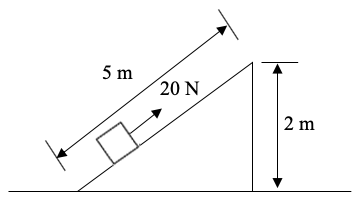
Image Credit: GenieSmart
What is the work done by the 20 \(\text{N}\) force to move the block up the slope?
- 40 \(\text{J}\)
- 80 \(\text{J}\)
- 100 \(\text{J}\)
- 200 \(\text{J}\)
Solution:
Option C is the correct answer
Explanation:
From the above diagram we see that the force of 20 \(\text{N}\) is being used to push the block up the inclined plane. The distance it moved in the direction of the force applied is 5 m
\(\begin{align} \text{W } &= \text{ F } \times \text{ s}\\[2ex] \text{W } &= 20 \times 5\\[2ex] &= 100 \text{ J} \end{align}\)
Question 4:
The diagram shows a girl lifting a box of weight 100 \(\text{N}\) from a low shelf to a high shelf.

Image Credit: GenieSmart
How much work is done by the girl?
- 50 \(\text{J}\)
- 100 \(\text{J}\)
- 150 \(\text{J}\)
- 200 \(\text{J}\)
Solution:
Option B is the correct answer
Explanation:
\(\text{Work done } = \text{ Force } \times \text{ Distance Moved}\)
Force required to lift the box should be equal to the weight of the box.
\(\begin{align} \text{W } &= \text{ F } \times \text{ s}\\[2ex] \text{W } &= 100 \text{ N} \times \text{ 1.0 m}\\[2ex] &= 100 \text{ J} \end{align}\)
Question 5:
A person exerts a horizontal force of 500 \(\text{N}\) on a box, which also experiences a frictional force of 100 \(\text{N}\).

Image Credit: GenieSmart
How much work is done against friction when the box moves a horizontal distance of 3.0 m?
- 300 \(\text{J}\)
- 1200 \(\text{J}\)
- 1500 \(\text{J}\)
- 1800 \(\text{J}\)
Solution:
Option A is the correct answer
Explanation:
The keyword here is work is done against friction.
This means we need to find out how much energy is required to overcome the frictional force. So we need to consider the force of friction.
\(\begin{align} \textbf{W } &= \text{ Friction force} \times \text{distance moved }\\[2ex] \textbf{W } &= 100 \times 3\\[2ex] &= 300 \text{ J} \end{align}\)
This is the energy lost due to friction. This is the work done against friction.
Option B: 1200 \(\text{J}\)
\(\begin{align} \textbf{W } &= \text{ Resultant force} \times \text{distance}\\[2ex] &= (500-100) \times 3\\[2ex] &= 400 \times 3\\[2ex] &= 1200 \text{ J} \end{align}\)
This is the net energy received by the box. This is the work done ON the box.
Option C: 1500 \(\text{J}\)
\(\begin{align} \textbf{W } &= \text{ Force applied by you} \times \text{distance moved}\\[2ex] &= 500 \times 3\\[2ex] &= 1500 \text{ J} \end{align}\)
This is the work done by YOU. This is the amount of energy you applied to push the box.
No Work Done
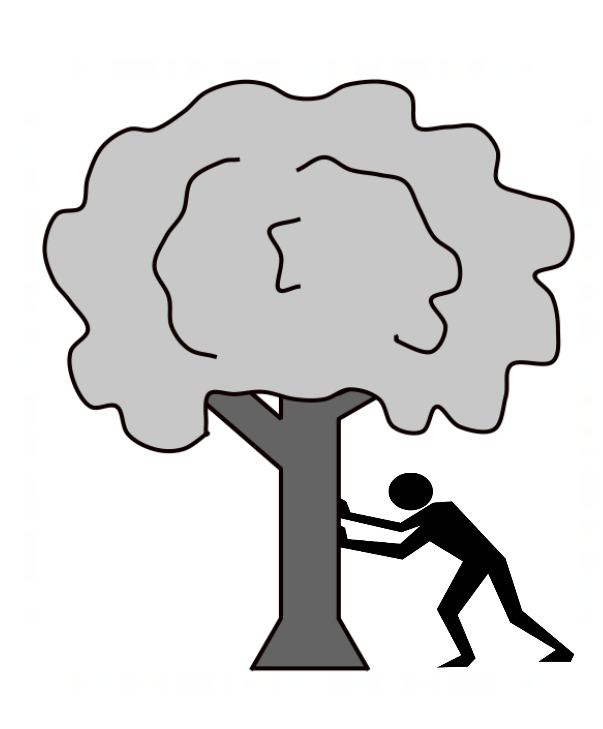
Image Credit: GenieSmart
No work is done when the object does not move even when the force is applied.
For Example:
A man is pushing a tree. But the tree does not move.So there is NO work done. However, he will still get tired. But scientifically speaking, there is no work done as the tree does not move.
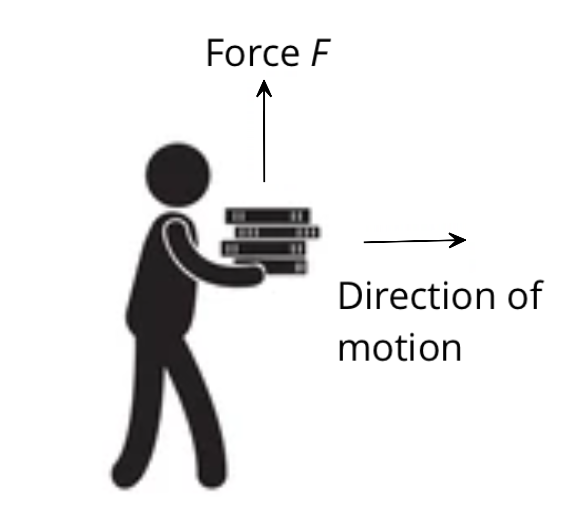
Image Credit: hiclipart.com
Another situation in which the work is not done is when the direction of the applied force and the direction in which the object moves are perpendicular to one another.
A man carrying a load while walking does no work on the load in the vertical direction as the load is only moving horizontally.
Question 7:
Which of the following does work done not depend on?
- Whether the object moves.
- The direction in which the force is applied.
- The size of the force applied.
- The size of the object.
Solution:
Option D is the correct answer
Explanation:
Option A - is correct. If the object does not move, then no work is done. If the object moves, then only work is done.
Option B - is correct. The object must move in the direction of the force, then only work is done.
Option C - is correct. The more the force, the more work is done.
Option D - is wrong. The work done is independent of the size of the object.
Question 8:
The diagram below shows a ball tied to one end of a rope. The other end of the rope is held by hand. The ball is made to move in a circle at a constant speed on the smooth, horizontal surface of a table.

Image Credit: GenieSmart
The rope exerts a constant force perpendicular to the circular motion of the ball. What is the work done by this constant force on the ball when the ball completes one revolution?
- 0 \(\text{J}\)
- 2.0 \(\text{J}\)
- 4.0 \(\text{J}\)
- 12.6 \(\text{J}\)
Solution:
Option A is the correct answer
Explanation:
Since the force exerted by the rope is perpendicular to the motion of the ball, NO work is done.
For a circular motion, the force exerted is always towards the centre and the motion is always tangential. So the angle between the force and the motion is always perpendicular. Thus, in a circular motion, work done ON the object is always ZERO.
Conclusion
In this article, we have learnt about
- Different Types of Energy
- Kinetic energy
- Potential energy
- Work Done
- On the object
- Against the friction
- No work done
Test Yourself
What is the energy conversion taking place in a microphone?
I: magnetic energy into electrical energy.
II: sound energy into electrical energy.
III: electrical energy into sound energy.
IV: sound energy into chemical energy.
A microphone converts the sound energy of the speaker into electrical energy which can be transmitted to a speaker or other signals.
Ans: (II) sound energy into electrical energy.
An owl in a tree of height h has a mass of 4 kg. It loses 800 J of gravitational potential energy to catch a mouse at the bottom of the tree. What was the initial height, h, that the bird was at?
Loss in gravitational potential energy = mgh
h = 800 ÷ (4×10) = 20 m
Ans: (C) 20 m
The diagram shows a girl lifting a box of weight 100 N from a low shelf to a high shelf.
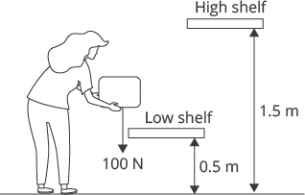
How much work is done by the girl?
Height moved = 1.5 − 0.5 = 1.0 m
Work done = 100 × 1.0 = 100 J
Ans: (B) 100 J
A battery can deliver 3000 J of energy to a small 2.0 W electric motor before the battery is exhausted. For how long does the motor run to produce the stated energy?
Using Time = Energy ÷ Power = 3000 ÷ 2.0 = 1500 s = 25 minutes
Ans: (A) 25 minutes
A person exerts a horizontal force of 500 N on a box, which also experiences a friction force of 100 N.
How much work is done against friction when the box moves a horizontal distance of 3.0 m?
Work done against friction = 100 × 3.0 = 300 J
Ans: (A) 300 J


 SG
SG  VN
VN 
